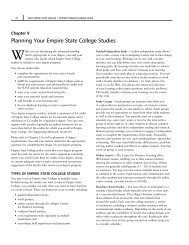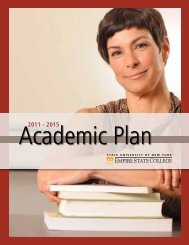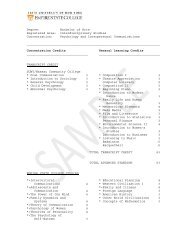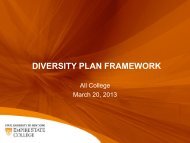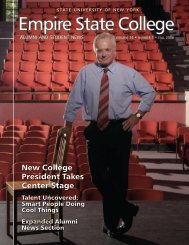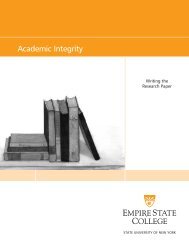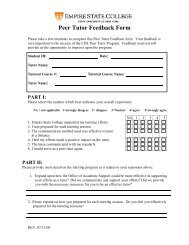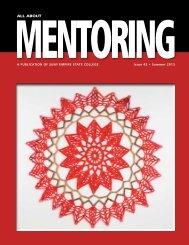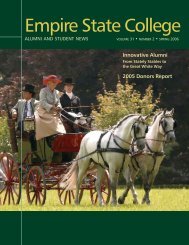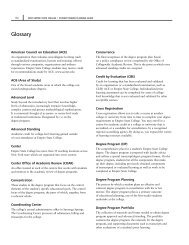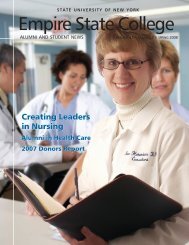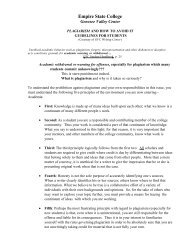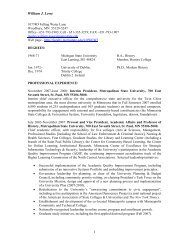All About Mentoring Spring 2011 - SUNY Empire State College
All About Mentoring Spring 2011 - SUNY Empire State College
All About Mentoring Spring 2011 - SUNY Empire State College
Create successful ePaper yourself
Turn your PDF publications into a flip-book with our unique Google optimized e-Paper software.
31<br />
Blended Learning Online:<br />
New Perspectives and Practices<br />
Sheila Marie Aird and Mary V. Mawn, Center for Distance Learning<br />
This reflection will offer an additional<br />
way to define “blended learning.”<br />
To date, most models of educating<br />
have been discussed and approached from<br />
either a face-to-face model, face-to-face<br />
model with an online component, face-toface<br />
with a residency component, or simply<br />
online. Although the discussions about these<br />
models are complicated, and the camps<br />
of best versus better models will always<br />
exist, what is clear is that education as we<br />
know it is evolving on a daily basis. How<br />
students choose to be educated is not only<br />
creating a change in the learning landscape,<br />
but is ultimately changing the basic ways<br />
we educate and how we choose to blend<br />
or not to blend. We are left to deal with a<br />
central question: How do we educate in a<br />
meaningful way that allows the student to<br />
empower themselves and drive their own<br />
educational pursuits<br />
The idea of blended learning is not a new<br />
concept. Garrison and Kanuka (2004)<br />
describe blended learning as “both simple<br />
and complex”:<br />
At its simplest, blended learning is the<br />
thoughtful integration of classroom<br />
face-to-face learning experiences with<br />
online learning experiences. There is<br />
considerable intuitive appeal to the<br />
concept of integrating the strengths<br />
of synchronous (face-to-face) and<br />
asynchronous (text-based Internet)<br />
learning activities. At the same time,<br />
there is considerable complexity in its<br />
implementation with the challenge of<br />
virtually limitless design possibilities<br />
and applicability to so many contexts.<br />
(p. 96)<br />
Heinze and Proctor (2004) define blended<br />
learning in a more generalized fashion:<br />
“Blended learning is learning that is<br />
facilitated by the effective combination<br />
of different modes of delivery, models of<br />
teaching and styles of learning, and founded<br />
on transparent communication amongst all<br />
Sheila Marie Aird<br />
parties involved with a course” (p. 10). In<br />
fact, this second definition describes what<br />
mentors and students having been doing at<br />
<strong>Empire</strong> <strong>State</strong> <strong>College</strong> throughout its history.<br />
While the majority of students at the<br />
college’s Center for Distance Learning (CDL)<br />
study at a distance, they too are engaged in<br />
different learning models. For the sake of<br />
this discussion, we would like to share some<br />
examples of how “blending” can be viewed<br />
through another lens. The discussion we<br />
offer will focus on how we “blend” at CDL,<br />
and the infinite possibilities that can develop<br />
from using these approaches to engage,<br />
enlighten and place education in the hands<br />
of the student.<br />
Although this reflection is not a pedagogical<br />
discussion per se, it is an attempt to create<br />
dialogue, raise awareness and expand the<br />
definition of how we view and describe<br />
blended learning.<br />
Blended Distance/E-Learning<br />
Distance learning has changed dramatically<br />
in the shift from print-based to Web-based,<br />
which has informed how we interact<br />
Mary V. Mawn<br />
with and educate our students. Another<br />
ingredient is today’s student of the digital<br />
age, who is often seeking a more interactive<br />
and authentic online experience. Defined<br />
as the 21st century learner, this group<br />
of students is quite comfortable with<br />
blogs, wikis and other social media. A<br />
recent article in Education Week (2010)<br />
asked: “How do you define 21st-century<br />
learning” Responses from 11 educators<br />
pointed to the need for learner-centered,<br />
real-world educational opportunities.<br />
One expert states, “Twenty-first century<br />
learning will ultimately be ‘learner driven,’”<br />
while a second states, “Students in the<br />
21st century learn in a global classroom<br />
and it’s not necessarily within four walls.”<br />
Individualized and lifelong learning are also<br />
key elements. As another respondent stated:<br />
“No longer does learning have to be onesize-fits-all<br />
or confined to the classroom.<br />
The opportunities afforded by technology<br />
should be used to re-imagine 21st century<br />
education, focusing on preparing students to<br />
be learners for life” (p. 32).<br />
suny empire state college • all about mentoring • issue 39 • spring <strong>2011</strong>




